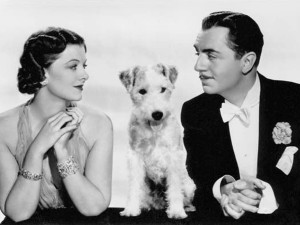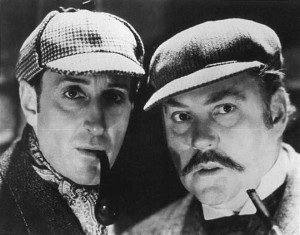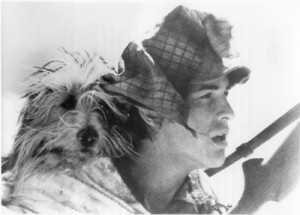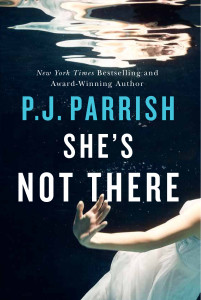By PJ Parrish
When I was a kid, I feasted on Nancy Drew. What future crime dog of the female persuasion didn’t? The blonde sleuth from River Heights was our lodestar.
Back in the Fifties, I had all the books, the ones with the beautiful dust jackets. Alas, I don’t have them anymore. They went the way of my original DC comics and my Beatle dolls. I don’t do well in the stock market either.
I’ve been re-collecting the old Nancy books for the last decade or so and the other day, just for fun, I cracked open a copy of one of my favorites, The Clue in the Crumbling Wall. And there she was.
Not Nancy but her chum George Fayne. And she was just like I remembered her – brown-eyed, short dark hair, tom-boyish, a little clumsy.
Not at all like Nancy. But a lot like me.
I admired Nancy. But I loved George. She was the anti-Nancy, flawed and human. Through more than 60 adventures, she was always there at Nancy’s side, along with the other cousin, Bess. (That’s George at left with the dark hair). Revisiting Nancy and George got me thinking about how important sidekicks are in mystery series. Sure, there are some lone wolves — Jack Reacher and James Bond come to mind. But most series feature one and sometimes two secondary characters who orbit the stars and provide needed reflective light.
I love sidekicks, as a writer and a reader. I think this is because while the hero represents the ideal, who we might want to be, the sidekick is who we really are. Okay, we’re not super-heros and we don’t save the day. But we like to think of ourselves as reliable, steadfast, smart and…there when needed.
My own series hero Louis Kincaid was a lone wolf in the early books. Yes, there were secondary characters who helped him solve the cases. But then, in book five, this burned-out, half-blind detective Mel Landeta walked on stage. He was supposed to be a cameo, just another case facilitator. But he was so damn interesting. And as part of Louis’s character arc, he needed to start adding “family” to his life. So Mel got to stick around.
If you are considering a series, it’s a good idea to think hard about second bananas. First, they have great appeal. (Sorry, I had to get that out of my system before I could go on). But they are also very useful. More on that in a moment but first, it might be useful to examine the different types of pairings you might create:
The Teammate: This is actually a dual protagonist situation, wherein there are two equally active case solvers. The classic example is Dashiell Hammett’s Nick and Nora Charles. (Maybe Asta the dog was the sidekick?) Modern examples are Paul Levine’s Steve Solomon and Victoria Lord, and SJ Rozan’s Lydia Chin and Bill Smith (who appear in alternating books and sometimes together).
The Sidekick. This character is not an equal to the protag but almost as important in propelling the plot. He or she is a fixture in a series, a reoccurring character. The classic example, of course is Holmes and Watson. But others include Nero Wolf and Archie Goodwin, or Cocker and Tubbs from the old Miami Vice series.
The Confidant: One step lower on the totem, this character might not actively work a case with the hero, but acts as a sounding board for the hero. My fave confidant is Meyer, who sits on the Busted Flush sipping scotch and spouting wisdom about chess and economics as he listens to Travis McGee ponder out the case. (or his latest lady problem) Meyer serves as an anchor of sorts when McGee’s moral compass wanders. More on that later!
The Foil: Some folks use “foil” and “sidekick” interchangeably, but I think the foil deserves its own category. This a character who contrasts with the protag in order to highlight something about the hero’s nature. Hence the word “foil” — which comes from the old practice of backing gems with foil to make them shine brighter. We can go all the way back to the first detective story to find a great foil: In Poe’s The Purloined Letter, the hero Dupin has the dim-witted prefect of police Monsieur G. Some folks might even say Watson is a foil for Holmes because his obtuseness makes Holmes shine brighter.
Or consider Hamlet and Laertes. Both men’s fathers are murdered. But while Hamlet broods and does nothing, Laertes blusters and takes action. And the contrast sheds light on Hamlet’s character. Hamlet himself says, “I’ll be your foil, Laertes. In mine ignorance your skill shall, like a star in the darkest night, stick fiery off indeed.”
Non-Human Helpers: Okay, this is for fun but hey, there’s a whole sub-genre devoted to this one — cat mysteries with dogs are coming on strong. My favorite in this category is Harlan Ellison’s chronicles: A Boy and His Dog, which tells the story of Vic and his telepathic dog Blood trying to survive the post-apocalyptic world after a nuclear war. And don’t forget Wilson the volley ball. In the movie Cast Away, he’s the only being Tom Hanks gets to talk to with such memorable dialog as “Don’t worry Wilson, I’ll do all the paddling. You just hang on.”
Before we move on, let’s take a break for a quiz. Here’s a list of sidekicks in mysteries. How many of their hero-friends can you identify? (Answers at end. Don’t cheat.).
1. Ricardo Carlos Manoso, AKA Ranger.
2. Clete Purcell
3. Vinnie LeBlanc
4. Win Horne Lockwood III
5. Bunter
6. Mouse Alexander
7. Barbara Havers
8. Hamish
9. Salvatore Contreras
10. Mutt
Now let’s look at exactly how a good sidekick or confidant can help both your plotting and your character development.
They inject a sense of normalcy. Because we are asking them to shoulder the plot, protags can sometimes feel super-sized. Sherlock Holmes is hyper-intelligent, violin-playing, abrupt and sort of misanthropic. So we get Doctor Holmes to relate to.
They humanize the hero. Holmes can be an arrogant SOB, but his kindness toward Watson makes him more likeable. And consider Sue Grafton’s Kinsey Milhone. She has no family (two ex husbands don’t count) and no real friends. But her friend old Henry Pitts is there with fresh baked cookies and a shoulder to cry on – and to hear her work out a case.
They illustrate the hero’s backstory. We all know the dangers of inserting the dreaded info-dump into our stories. One of the most graceful ways of giving our hero context and background is through the point of view of a sidekick.
They provide access to authority. This is vital to those of you who write an amateur sleuth. How do you get your protag needed access to police, forensics, case files and all the tools needed to solve the mystery? If your heroine runs a B&B in Maine, you give her a buddy on the local force. Dorothy L. Sayer’s Lord Peter Wimsey has Charles Parker as his police contact.
They can darken your story’s chroma: Sometimes, you just need a character who is a little off the grid, someone who can do the dirty deeds that you don’t want to give to your hero. Robert B. Parker uses Hawk in this manner, as does Robert Crais whose silent Joe Pike is yin to Elvis Cole’s yang.
They give a different point of view. A sidekick offers a chance for a different interpretation of whatever is happening in the story.
They serve as a sounding board. This is vital to propelling your plot forward. Yes, you can have your hero sitting around reading case files or have a your PI noodling out the clues in his head. Snooze-fest! Dialogue is the life blood of good plotting so give your hero someone to talk to. Give your McGee a Meyer.
Okay, now let’s go over some quick do’s and don’t’s regarding these folks.
DO: Establish the bond. The first rule is that the primary relationship between the main character and the sidekick is trust and loyalty. Their bond is unbreakable, though the reader needn’t necessarily know this. It is your job to build this relationship with believability and even some tension. One of the best ways to inject momentum in the middle of a story is to create a riff in the team. (Remember the guys fighting on the Orca in Jaws?) Think of the jolt your story can get if, for some plot reason, you break the team up then later have the hero saved by the unexpected return of the contrite sidekick. I used this in the first book with Mel Landeta and Louis. They start at loggerheads, become allies, then split before coming back together. That tension helped propell the middle of the book, much like a good romance gets its tension from boy-gets-girl-boy-loses-girl-etc.
DON’T: (Okay…I’m going out on a limb here.)…have them fall into bed. This is just me, I know. But I think you risk letting all the steam out of a team when romance rears its ugly head. Moonlighting lost its luster once Maddie and David jumped in the sack. Now it’s your turn and tell me why I am wrong about this. Go ahead…I can take it.
DO: Make your sidekicks human and colorful. Give them idiosyncracies and their own full dossiers. Don’t make them easy stereotypes. Don’t give us another Hawk or Pike. Others have tilled that soil.
DON’T: Give them weird tics like bad dialects. Or make them whiners. Or have them come across as dense. That won’t reflect well on your protag. Like a well-written villain, a sidekick must be worthy of the hero’s attention, if not respect.
DON’T: Let them overshadow the hero. This is important. Take it from me. In one of our later Louis books, my editor came back with the criticism that Mel was getting all the good lines and was looking smarter than Louis. We had to do major rewrite to get the spotlight back on our hero. There is something about writing secondary characters that frees us to indulge our best creative tendencies. Because they don’t shoulder the plot, they can be more fallible, crazier – a lot more fun. But the sidekick should never be more interesting or complex than the hero. The sidekick tends to be steadier in mood and temperament. Remember Fonzie? He was a lot more fun to hang around with than Richie Cunningham. At least until he jumped that shark.
Which brings me back to George Fayne. Back in the Fifties, when I was gorging on the Nancy Drew books, little did I know…
Turns out George is a lesbian icon. She’s got her own chapter in a scholarly book, The Lesbian Menace: Ideology, Identity, and the Representation of Lesbian Life. She was the topic of a panel at a conference called “Lesbian Code in Nancy Drew Mystery Stories.” She is beloved on butch blogs.
To which the 87-year-old ghost-writer of the series Mildred Benson once responded to a New York Times reporter, “This is the silliest, most out-of-the-picture thing I’ve ever heard! I’d like to blow a cork!”
Amen, sister. I mean, who cares about George’s sex life? To me, she was just fun to hang around with.
Postscript: Please bear with me for a little BSP: My publisher is running a book giveaway of my September release SHE’S NOT THERE over at Good Reads this month. If you’d like to sign up to get a free copy of the lovely trade paperback, please CLICK HERE. Now we return to our regular programming.
QUIZ ANSWERS
1. Stephanie Plum (Janet Evanovich)
2. Dave Robicheaux (James Lee Burke)
3. Alex McKnight (Steve Hamilton)
4. Myron Bolitar (Harlan Coben)
5. Lord Peter Wimsey (Dorothy L. Sayers)
6. Easy Rawlings (Walter Mosley)
7. Inspector Thomas Lynley (Elizabeth George)
8. Ian Rutledge (Charles Todd)
9. V. I. Warshawski (Sara Paretsky)
10. Kate Shugak’s dog (Dana Stabenow)






Wow, Kris, the best article I’ve read on sidekicks…ever. I’m printing this one out.
And thanks for the link to the book giveaway for SHE’S NOT THERE.
By the way, all the women who show up in my office reading mysteries – I give them PJ’s name and tell them about Louis.
I agree with you on keeping the protag and the sidekick out of bed. Love the phrase “steam out of the team.” The romantic tension is gone when the bed scene is over. Keep the tension; lose the bed.
Thanks for a wonderful post!
Thanx for dropping in Steve…and for the office word of mouth!
I thought I’d check in, “just for a minute” because I’m supposed to be leaving for the Writers’ Police Academy soon — engrossing post, as always, Kris. In my romantic suspense books, I’ve found that although the h/h duo isn’t really hero/sidekick, having a ‘naive’ character who’s outside the world of the protagonist on board helps avoid As You Know Bob passages, and also lets you point out to readers that real cop work isn’t television.
In my series, I’ve got Gordon’s best officer around to bounce things around with, and I think/hope I’ve covered your dos and don’ts in their relationship. Then, there’s the big city homicide detective to play ‘thorn in the side’ sidekick, although deep down, they do work together.
OK — I have to pack!
I love that phrase…”as you know, Bob.” Am filing that one away.
Have a good time at the academy. Have always wanted to go to one of those.
Good comments, even for those of us that don’t write detective fiction. In my NIP (women’s fiction), I’ve given my protagonist a best friend who hits on a lot of the points you cover above. Thanks for the post! Lots of good info here.
Dontmentionit, Maggie. This topic is near to my heart.
P.J.,
Like Steve, I’m saving this post. I think you hit the core appeal of sidekicks with your insightful observation: “the hero represents the ideal, who we might want to be, the sidekick is who we really are.” Thanks for a really great analysis of why/how they help our stories.
Glad to be of help, Debbie. Thanks for coming by.
Fantastic story today, Kris! I still love the reaction I get when I’m asked what I’ve written, and I mention that I once wrote Nancy Drews under contract. (Not that I did it all that well–one of my books is actually cited on Wikipedia for starting the trend of making Nancy too girly and boy-focused. Sorry about that, folks!) Your post is timely for me, because I just got feedback from my critique group that my sidekick is much more appealing than the main character. That’s what I’m working on at this very moment–going back and balancing the focus. Thanks for the tips!
p.s. My favorite type of sidekick (esp. in movies) is the kind who sticks by the main character “until the last dog dies”, as we say down South. Extreme loyalty to the main character (especially when tested) helps underscore his or her heroic dimensions.
I forgot about your Nancy gig! I haven’t read any of the later Nancy books but it’s fun to read about how the girls have changed with the times. George is now a judo expert and a computer geek, I understand. 🙂
Nice post, Kris. Two of my favorite sidekicks were Tonto and Robin. In all of our thrillers (co-written with Lynn Sholes) we’ve used sidekicks. It takes some of the pressure off the protag. I’ve found them the most fun to write, too. One tip is to make the sidekick smart, but just slightly less that the hero. The protag still has the final responsibility to solve the puzzle.
Joe Moore: Tonto and Robin! Mine, too, but I would like to add Pancho, the Cisco Kid’s loveable side kick. Pancho, played by the late Leo Carrillo (of whom the state park was named), kept me laughing.
To this day, over 60 year later, I still tell people, “I didn’t realize you.” Many don’t know what that means.
It’s a secret between Leo Carrillo, us, and me. (It means, “I didn’t recognize you.”)
Thanks for the quick memory.
Here’s to the second bananas! Great post with useful info on what to do and not to do when it comes to them. I think secondary characters like these serve a vital role – and, especially if you have a ‘conflicted’ protagonist, they give the reader a chance to see a different side to them – maybe a more human side that cannot be shown when the principal character interacts with others.
I remember a panel at ThrillerFest, where Lee Child sat with several other writers who have sidekicks in their books. And he said, “Sdekicks? We don’t need no stinking sidekicks.”
The others blanched.
You mention one of my favorites: Meyer. I like the sidekick as conscience, telling the hero things he needs to hear.
Lee is a force unto himself. 🙂 Wish I had been there.
In Spencer Quinn’s (Peter Abraham’s) Chet and Bernie series, it’s really hard to say which one is the sidekick. The story is all told from Chet’s POV. But Bernie is the human, Chet is his dog. But because it’s all told by Chet, HOW he perceives things is half the fun of the stories, maybe three quarters. Somehow, between the two of them they manage to solve the crime and save the day, but it’s always a lot of fun watching them get there. Even when things get dark, and they get very dark sometimes, Chet is such on optimist and has such complete faith in Bernie (who Chet believes as an article of faith is “always the smartest guy in the room”) that I tilt toward him as the MC and Bernie the sidekick – as Chet would say – “if that makes any sense and it probably doesn’t, but never mind.”
Interesting, John. I’m not familiar with the series you mention but it sounds intriguing. I tend NOT to go for mysteries in which animals play a big part (which is odd considering I am a big dog lover). Maybe I should give this one a look.
Love your post, Kris. I once wrote a sidekick where in book #1 of my Sweet Justice series, Seth was a mystery through the whole book. I thought it would be fun for me to give him an unexplained background to intrigue my main protag (woman bounty hunter Jessica) and build upon his mystery til the last page.
Something happened to him at the end of book 1 and forced me to figure out his backstory in book 2 in order for the plot to continue. It was like painting myself in a corner without knowing how to extricate myself.
It was a fun exercise to determine a logical explanation for everything that I’d conjured. I chuckled when my editor and agent fell in love with him.
Jordan,
That is exactly what happened to us with Mel. On the first draft, he wasn’t all that interesting…he wasn’t meant to be a sidekick, just a walk on. But as the plot deepened, we realized, like you, that it wasn’t working, that his character demanded more of us. It’s frustrating when this happens but ultimately sort of thrilling once you figure it out.
I love challenges and wrote in outlandish things about him with loads of unexplained mystery. Because he was a secondary character, I didn’t need to explain him until he became the catalyst for book 2. Lots of fun.
Excellent article with great review of sidekicks’ purposes and functions. I might add in here comic relief as well.
Another printer-outter here~
🙂
Like the esteemed Me. Bell I’m glad you mentioned Meyer, too ~
I liked Jim Rockford’s dad in the Rockford Files (showing my age?), but so many of today’s crime dramas are so “ensemble” that they doesn’t give a lot of sidekick opportunities (though Castle – Beckett is an exception – not to mention he’s a writer).
Another thing a partner-in- grime allows is for the protag to “breathe”” a little and not carry the whole shebang (which also let a the WRITER rp catch his/her breath a sec by focusing on the story while not focusing on the story- if that makes sense).
Any way~ thanks for a great mini-lesson today.
g
Oh yeah…Rockford’s dad…what a great sounding board he was! Thanks for the memories.
Another first-rate post, Kris. I like your categories. And while I don’t care about George’s sex life — nobody in Nancy Drew had a sex life, not even Mr. Drew — I do think she grew up to be lesbian.
I am surprised you didn’t weight in with Margery! She’s a terrific secondary character in Helen’s life. I guess she’s not a true sidekick…is she more comic relief? Maybe Helen’s hubby is a sidekick cum dual protag?
I recently binged on CJ Box’s Joe Pickett (game warden) series and love the relationship between Joe and borderline criminal Nate Romanowski. Complex characters, very layered, but they push each other to do things they normally wouldn’t do. Great ethical conflict. As the series has developed, Joe & Nate have really grown as characters. Beautiful writing & intriguing characterizations. Highly recommended.
Yeah, JD. I thought Romanowski was great. My friend, a SEAL, is just like that.? And how are you doin’ these days?
Just occurred to me – Ranger isn’t really the “sidekick” in the Stephanie Plum novels, is he? That’s more Lula’s role, comic sidekick. Ranger is more the mentor, the wise guide. He’s sort of an Obi Wan – a hot, sexy smelling, ripped Obi Wan.
John,
You know, on second thought, you are right. Lulu is the true sidekick. I dunno…maybe this is a case of TWO second bananas, each filling a special role?
Most helpful explanation about side-kicks I’ve ever read. Thank you for that.
As for getting them in bed together, I agree with you if they’re not married. I do enjoy the couples who solve crimes together with a good dose of romance, bantering and even disagreements. Later seasons of Castle is a good example of what I mean.
I really wanted to use “She’s Not There” in the worst way. I listen to that song all the time. Whaddaya gonna do, eh?
One of my sidekicks is a woman 15 years older than the male MC. She was a good friend of his auntie and was a CIA operative (cover as a ballerina) who was shot in the leg in Saigon 1968. Subsequently, she ran the department of special effects and gadgets for the Company out of a trailer parked on the mall. So she has a nice background and provides a great counterpoint to the MC’s impetuous nature. Essentially, she knows everything and runs a bookstore called The Company Store in Seal Beach, CA, where they all live in funky beachfront cottages bought in the old days and now worth a fortune.